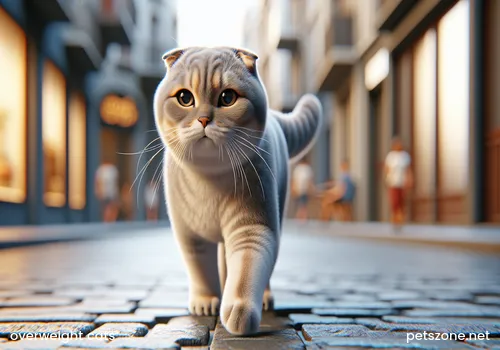The Dangers of Dieting Cats_Complete Analysis of Health Risks for Overweight Cats
Being overweight is not just about having a “chubby and cute” cat; the health risks it brings to our furry friends far exceed what many pet owners imagine. In fact, overweight cats face a series of severe health problems, including but not limited to diabetes, fatty liver, joint diseases, urinary system diseases, and it may even shorten their lifespan. Therefore, understanding these potential dangers and taking active measures to help cats maintain a healthy weight is a must for every responsible pet owner.

Why Do Cats Become Overweight?
Before discussing the health risks of overweight cats, let’s think about how these "little chubbies" come to be. The most common reasons are simply "unable to resist food and unwilling to exercise." The lifestyle of cats in modern homes is relatively leisurely with insufficient exercise, while many cat foods are very tasty, or the owner does not strictly control the feeding portions and gives too many snacks, leading to cats consuming far more calories than they expend. Over time, fat accumulates, and the weight naturally "rises rapidly." Additionally, some diseases (such as hypothyroidism) or medications (such as corticosteroids) can also cause weight gain, but the vast majority of cases are caused by lifestyle habits.
Analysis of Health Risks for Overweight Cats
Once a cat becomes overweight or obese, all systems of its body are negatively affected, much like an overloaded car where every part bears extra pressure.
1. Diabetes: Sweet Burden Turns into a “Sweet Bomb”
Diabetes is one of the most common endocrine diseases in overweight cats. Excess fat affects the body's sensitivity to insulin, causing cells to be unable to effectively use blood sugar, leading to continuously elevated blood glucose levels. This is very similar to human type 2 diabetes, medically known as “insulin resistance.” Cats with diabetes may exhibit symptoms such as excessive drinking, urination, increased appetite but weight loss. If not controlled timely, prolonged high blood sugar can damage multiple organs in cats such as kidneys, eyes, and nervous system, and can even cause ketoacidosis, a life-threatening emergency. Imagine, originally sweet cat food turning into a constantly accumulating “sugar bomb” inside the cat’s body, ready to ignite a health crisis. According to the Association for Pet Obesity Prevention (APOP) in the US, obese cats have a 4 times greater risk of developing diabetes than cats of normal weight.
2. Fatty Liver (Hepatic Lipidosis): The Silent Killer
Fatty liver, commonly called hepatic lipidosis in cats, is a very dangerous and potentially fatal disease, especially common in overweight or obese cats that suddenly lose their appetite. When a cat stops eating suddenly due to various reasons (such as stress, picky eating, or rapid dieting), the body mobilizes fat reserves for energy. However, the cat’s liver is not efficient at processing large amounts of fat, causing excessive fat to quickly accumulate in liver cells, leading to liver dysfunction or failure. It’s like an already “overburdened” cargo port suddenly overwhelmed by a massive influx of goods, piled high until it completely collapses. Symptoms of fatty liver include anorexia, vomiting, lethargy, and jaundice (yellowing of the skin and eyes) and require urgent nutritional support and medical intervention.
3. Joint Diseases: The “Old Age Disease” Arriving Early
Excess weight places huge strain on a cat’s joints, especially the hips, knees, and elbows. It’s like carrying a heavy backpack while walking, putting extra pressure on knees and back. Long-term overweight accelerates cartilage wear, leading to osteoarthritis. Cats with arthritis may show reluctance to jump, reduced activity, stiff gait, pain, and even limping. You may notice they no longer jump onto sofas as easily or become slow going up and down stairs. This condition not only affects their mobility and quality of life but also causes chronic pain.
4. Urinary System Diseases: Risks of Bladder Stones and Urinary Tract Infections
Overweight cats are more prone to urinary system diseases including bladder stones and urinary tract infections. Obese cats may find it harder to maintain hygiene around their perineal area due to their body shape, increasing the risk of bacterial infections in the urethra. Meanwhile, their water intake may be relatively low, resulting in concentrated urine that increases the risk of stone formation. Once urinary system diseases occur, cats may have symptoms such as difficulty urinating, pain, blood in urine, and frequent licking of genitals. More seriously, if a stone blocks the urethra, it can cause uremia, a life-threatening emergency that requires immediate treatment.
5. Cardiovascular Diseases: The Invisible Health Killer
Although cardiovascular diseases are not as common in cats as in humans, overweight is still a risk factor. Obesity increases the heart’s workload, like an overworked engine, eventually damaging the heart muscle and possibly causing hypertension, cardiomyopathy, and other issues. Early stages may have no obvious symptoms, but long-term effects can severely impair heart function and may even induce heart failure.
6. Decreased Immunity and Other Risks
The immune function of overweight cats may be impaired, making them more susceptible to infection and slower to recover. Additionally, obesity is associated with increased anesthesia risk, skin problems (such as dermatitis and matted fur), breathing difficulties (especially in flat-faced cats like Persians), and impaired temperature regulation. For example, overweight cats are more likely to suffer heatstroke in hot summers because of reduced heat dissipation ability.
How to Determine if a Cat is Overweight?
Owners can preliminarily judge the cat’s weight status by the “bone feeling method” and “observation method”:
- Ideal weight: Gently feel the cat’s ribs on both sides—you should be able to clearly feel them but they shouldn’t protrude. Viewed from above, the cat should have a distinct waist curve; viewed from the side, the abdomen should slightly tuck up.
- Overweight: You need to apply a little more pressure to feel the ribs, the waist curve is not obvious, and the abdomen starts to sag.
- Obese: You cannot feel the ribs, the waistline disappears completely, the abdomen is obviously sagging, sometimes forming a “pot belly.”
If uncertain, the best approach is regular check-ups at the veterinary clinic so a professional vet can assess the cat’s weight and physical condition.
The Weight Loss Journey for Overweight Cats
Once a cat’s overweight status is confirmed, losing weight becomes an urgent task. But this is never an overnight process and requires patience and scientific methods. Avoid “one-size-fits-all” rapid dieting.
- Create a scientific diet plan: Under veterinarian guidance, choose prescription or low-calorie cat food suited for weight loss, strictly control feeding amounts, and eliminate unhealthy snacks. Gradually reduce calorie intake instead of sudden drastic cuts.
- Increase exercise: Encourage the cat to play more using toys like wand teasers, laser pointers, cat trees, engaging in interactive games at least twice daily for 10-15 minutes. If possible, try a cat treadmill or puzzle toys to increase activity.
- Regular weight monitoring: Weigh the cat weekly or biweekly, record weight changes, and adjust diet and exercise plans according to vet advice.
- Patience and persistence: Cat weight loss is a long process, usually taking months or even longer. Owners need to stay patient and consistent.
Frequently Asked Questions
- Q1: What are the risks if a cat loses weight too quickly?
A1: Rapid weight loss in cats, especially with insufficient energy intake, mainly risks triggering fatty liver. This is because the cat’s liver is inefficient at processing large fat reserves, and sudden energy restriction causes rapid fat accumulation in the liver leading to serious liver dysfunction. Therefore, cat weight loss must be gradual and supervised by a veterinarian. - Q2: How to tell if a cat has diabetes?
A2: Common symptoms of feline diabetes include excessive drinking, frequent urination, increased appetite but weight loss. You might notice water bowls emptying faster, more litter box waste, or the cat appears constantly hungry but losing weight. If these signs appear, take the cat immediately to the vet for blood sugar and urine tests for diagnosis. - Q3: Can arthritis in overweight cats be cured?
A3: Osteoarthritis is a degenerative disease with no complete cure currently but can be effectively managed through weight control, pain relief medications, joint supplements, and physical therapy to relieve pain and improve quality of life. Weight loss is key to reducing joint stress. - Q4: How much weight is considered overweight for cats?
A4: Ideal weight ranges vary depending on breed and body type, but generally, if a cat’s weight exceeds its ideal weight by 10%-15%, it is considered overweight. For example, if a cat’s ideal weight is 4 kg but it reaches 4.5 kg, it is overweight. The most accurate method is to use body condition scoring (BCS) combined with veterinary professional assessment. - Q5: How to increase activity in cats that dislike exercise?
A5: For inactive cats, try diverse interactive games, such as using laser pointers and feather wands to stimulate jumping and chasing; hiding food so they “hunt” for it; providing cat trees or climbing towers to encourage vertical movement; or using puzzle feeders to combine mental and physical activity while eating.
Conclusion
Love them by giving them a healthy body. The health risks caused by feline overweight are not to be underestimated. Behind every chubby “master” may lurk hidden health hazards. As pet owners, we have the responsibility to help manage their weight, keep them free from disease troubles, and enable them to enjoy a longer, healthier, and more energetic life. This is not only love for the cat but respect for life.
References:
- According to the report by the Association for Pet Obesity Prevention (APOP), obese cats have a 4 times greater risk of developing diabetes compared to cats of normal weight.
-560x560.webp)




-560x560.webp)